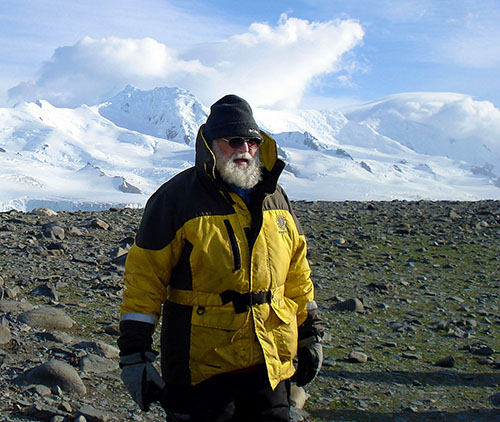
Glaciologiste • Etats-Unis
L’Antarctique est l’endroit de la planète où des hommes et des femmes de tous pays, quelques soit leurs origines culturelles, vivent et travaillent ensemble en bonne harmonie
Dr. Richard L. Cameron has a B.Sc. in Geology from the University of New Hampshire. He made his graduate in glaciology and Quaternary studies at the University of Stockholm and his Ph.D in Geology from The Ohio State University. In 1957, he first wintered in Antarctica at Wilkes Station. He has been Chief of Geotechnics Branch, Terrestrial Sciences Laboratory, Air Force Cambridge Research Laboratories; Assistant to the Director, Institute of Polar Studies, Ohio State University as well as Assistant Dean of University College and Assistant Dean for International Programs; Program Manager for International Organizations, International Programs and then Program Manager for Glaciology for the Division of Polar Programs of the National Science Foundation.
My cousin gave me a copy of “The Royal Road to Romance”, by Richard Halliburton, which peaked my interest in seeing the world. In 1953 between my junior and senior year at college I attended of The University of Oslo Summer School and then worked with the Norwegian Polar Institute on glaciers in Norway. After that I knew what I would be doing for my life’s work: Greenland 1954; Sweden 1955; Antarctica 1956-1958; and so on studying glaciers. I eventually became the Glaciology Program Manager in the Division of Polar Programs. When I was at the National Science Foundation I was on a committee studying the possibility of towing icebergs as a source of water for Saudi Arabia. Prince Mohamed al Faisal al Saud was funding the project. I received a call that a meeting was to be held the following week in Paris. I said I was particularly busy and probably could not make it. They said, “Take the Concorde”. I said, “I’m coming”. It took three and a half hours to get there from Washington, D. C. Halfway across the Atlantic on the return flight I was invited up to the flight deck and sat for some time with the pilots. Quite a thrill and at 60,000 ft. you can see the curvature of the Earth. During the austral season 1964-1965 I participated in the Queen Maud Land Traverse from the geographical South Pole to the Pole of Relative Inaccessibility in the middle of East Antarctica. Charlie Bentley lead the first half of the traverse and yours truly the second half. Going from 2 820 m (9,250 ft). elevation at the South Pole to 3 657 m (12,200 ft). at Inaccessibility we travelled 1 200 km (750 miles) at the breakneck speed of 8 km/h (5 miles per hour). Undertaking a series of studies en-route, the traverse took two months. It was exciting to be crossing a part of the Earth where no man had been before. A great moment for me was standing at the geographical South Pole with my son Andy in November of 1979. He was just finishing his winter-over year at the Pole and I had just arrived to be the NSF Representative at the Pole for the summer. Antarctica is a special place; as I consider it the epitome of the way the rest of the world could one day be. It is a place where men and women of all nations and ethnic backgrounds can live and work in harmony. The IGY was the prime example of cooperation ‘ON ICE” when their respective countries were at odds with one another.
Decembrer 2014

